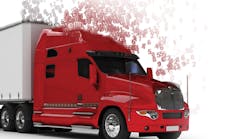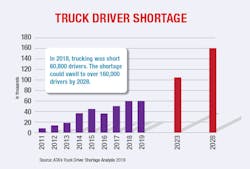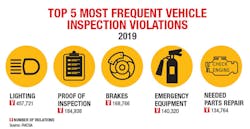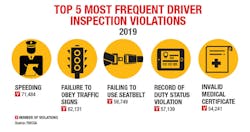This year, the trucking industry has proven to be particularly vital to the American economy and way of life. In March, the familiarity of daily life in the U.S. was upended when the COVID-19 pandemic ramped up in the U.S. But fleet owners and operators, dispatchers, back-office staff, and, of course, drivers persevered and kept freight moving.
As Karl Moor, deputy assistant administrator for the U.S. Environmental Protection Agency’s Office of Air and Radiation, pointed out during this year’s SmartWay Excellence Awards, there is not a family in America or business that doesn’t rely on the freight industry in some way. On average, he said, each day, the transportation system in the U.S. moves about 49 tons of freight valued at more than $53 billion per day.
According to Bob Costello, chief economist for the American Trucking Associations (ATA), trucks move roughly 72.5% of the nation’s freight by weight. Trucking also moves $791.7 billion in gross freight revenues, which represented 80.4% of the nation’s freight bill in 2019, according to ATA data. In addition, trucks moved 11.84 billion tons of freight in 2019, representing more than 72% of total domestic tonnage shipped.
And, for the better part of 2020, trucking companies and their drivers worked around the clock and braved the unknown to make sure essential supplies got to where they needed to be. Throughout the year, refrigerated trailer units were also used as mobile morgues for hospitals overwhelmed by COVID-19 deaths.
According to the U.S. Department of Transportation, as of April 2020, the number of for-hire carriers on file with the Federal Motor Carrier Safety Administration totaled 928,647, private carriers totaled 799,342, and other interstate motor carriers totaled 84,763. Other motor carriers are those that did not specify their segment or checked multiple segments.
Overall, roughly 8 million people were employed in trucking-related jobs as of 2019, with 3.6 million of those being truck drivers. But the industry still faces an ongoing and worsening labor shortage. For the fourth consecutive year, the driver shortage was the top industry issue overall on the American Transportation Research Institute’s Top Industry Issues list. And this year, the driver shortage is expected to be even worse due to a pandemic-induced closure of driver training schools and commercial driver license testing sites. The driver shortage problem has also been compounded by stricter drug and alcohol testing mandates, an older demographic of drivers retiring from the industry, and the fact that women and minorities still represent a small fraction of the driving force.
Another challenge for fleets and drivers is that nearly three-quarters of the nation’s total domestic tonnage is hauled on deteriorating roads and inadequate infrastructure, which costs drivers and fleets time and money. When it comes to highway taxes, commercial trucks paid $45.7 billion in federal and state highway-user taxes in 2018. Even though commercial trucks make up 13.7% of all registered vehicles, they paid $18 billion in federal highway-user taxes and $27.7 billion in state highway-user taxes in 2018.
This year, FleetOwner's Trucking by the Numbers feature provides a snapshot of just how vital the trucking business remains for the U.S. economy. For the December issue of the magazine, sections were broken up by overview, which includes industry segments, global and domestic trends, and freight forecasts, among others; COVID-19, which provides a glimpse as to how the pandemic has impacted the freight industry; drivers; safety; traffic; equipment; and emissions and efficiency.
A digital version of the feature will be published in January. In the meantime, check out some of the highlights from each section.
COVID-19
Over the course of the year, the trucking industry distributed more than 1,000 gallons of hand sanitizer, 250,000 KN-95 masks, and helped FMCSA distribute more than 1 million masks.
The pandemic hit smaller fleets and owner-operators harder than their larger counterparts. According to an American Transportation Research Institute (ATRI) study, 39% of fleets with fewer than five power units reported "much lower" freight levels, while 30% of fleets with more than 1,000 power units reported their freight levels were "about the same" at the start of the pandemic.
ATRI also found that 80% of smaller fleets and owner-operators were less likely to have a disaster plan, while 70% of fleets with more than 1,000 assets had a disaster plan in place.
Traffic
Traffic congestion and truck bottleneck costs the industry and the economy a substantial amount of time and money. According to ATRI, congestion on the nation's highways costs the trucking industry $74.5 billion a year and 1.2 billion hours of lost productivity.
ATRI lists the top 10 truck bottlenecks of 2020 below:
Drivers
ATA analysis points out that in 2018, the trucking industry was short 60,800 drivers. ATA projects that if current driver turnover trends continue, the shortage could swell to over 160,000 drivers by 2028.
The average age of a driver transitioning into trucking is 36, while the average age drivers currently in the industry is 57, according to FMCSA's Deputy Administrator Wiley Deck.
Safety
During roadside inspections in 2019, FMCSA reports that the top five most frequent vehicle inspection violations were:
- Lighting
- Proof of inspection
- Brakes
- Emergency equipment
- Needed parts repair
The top five most frequent driver inspection violations in 2019 were:
- Speeding
- Failure to obey traffic signs
- Failure to use seatbelt
- Record of duty status violation
- Invalid medical certificate
In 2019, the total number of driver inspections, according to FMCSA, were nearly 3.4 million. Driver violations totaled 950,677, while the total number of driver out-of-service violations totaled 199,426.
Emissions and Efficiency
This year, 15 states and Washington, D.C., signed a memorandum of understanding that calls for only zero-emission commercial vehicles to be sold by 2050. The pact calls for only new medium- and heavy-duty zero-emission trucks and buses to be sold in their jurisdiction by 2050. They set a 30% goal of zero emission commercial vehicles by 2030, which will be reassessed in 2025 as new data comes in.
According to the U.S. EPA, medium- and heavy-duty trucks comprised 23% of greenhouse gas (GHG) emissions in the transportation sector in 2018. Light-duty vehicles comprised nearly 60% of GHG emissions.
Equipment
After a slump at the start of the pandemic in the U.S. in March, Class 8 truck orders are on this rise. According to data from FTR Transportation Intelligence, the 50,000 Class 8 truck order total for November — the third-highest in history — reflects the potential demand for the trucks and were driven by previous pandemic-related capacity constraints and OEM supply shortages.








